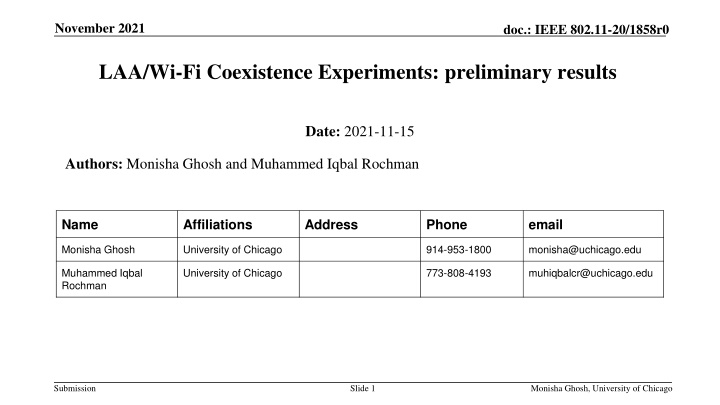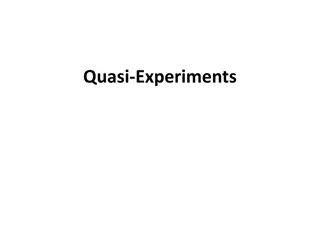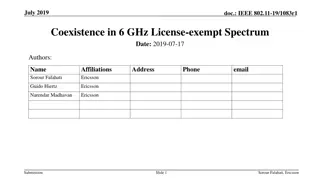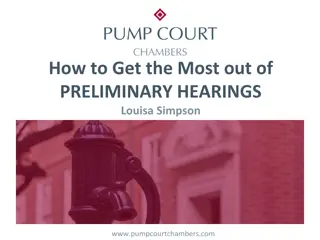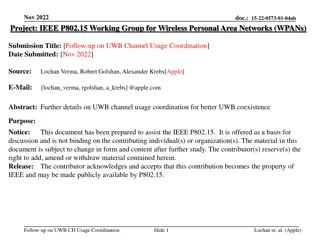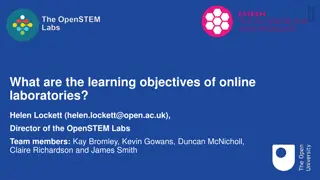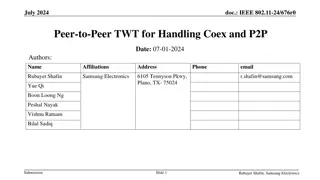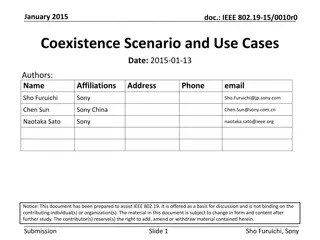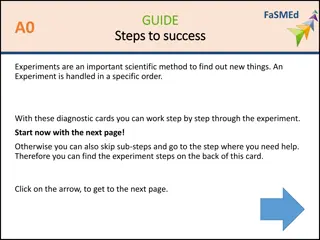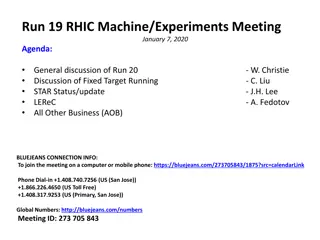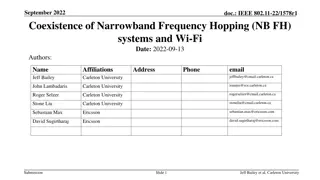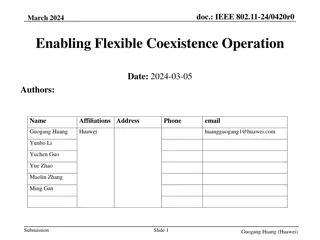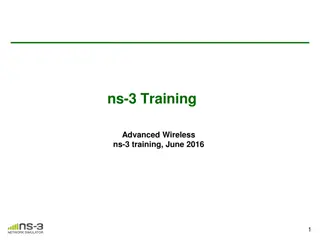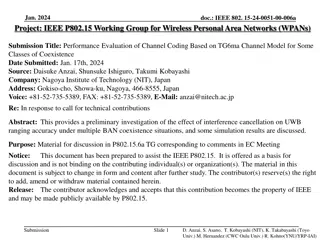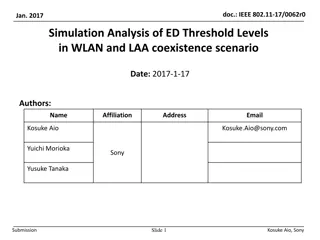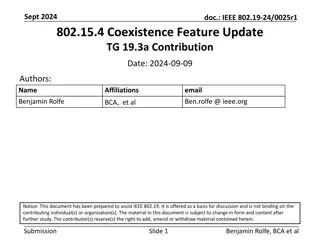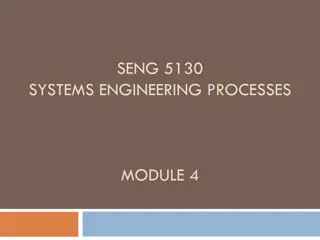Preliminary Results on LAA/Wi-Fi Coexistence Experiments
This document presents preliminary results from experiments studying the coexistence of LAA and Wi-Fi in different scenarios. The experiments reveal the impact of LAA operation on ambient Wi-Fi usage and the challenges faced by Wi-Fi clients in coexisting environments. Detailed experiments, including hidden node scenarios, client associations, AP deployments, and client activities, are described with insights into throughput degradations and transmission issues.
Download Presentation

Please find below an Image/Link to download the presentation.
The content on the website is provided AS IS for your information and personal use only. It may not be sold, licensed, or shared on other websites without obtaining consent from the author.If you encounter any issues during the download, it is possible that the publisher has removed the file from their server.
You are allowed to download the files provided on this website for personal or commercial use, subject to the condition that they are used lawfully. All files are the property of their respective owners.
The content on the website is provided AS IS for your information and personal use only. It may not be sold, licensed, or shared on other websites without obtaining consent from the author.
E N D
Presentation Transcript
November 2021 doc.: IEEE 802.11-20/1858r0 LAA/Wi-Fi Coexistence Experiments: preliminary results Date: 2021-11-15 Authors: Monisha Ghosh and Muhammed Iqbal Rochman Name Affiliations Address Phone email Monisha Ghosh University of Chicago 914-953-1800 monisha@uchicago.edu Muhammed Iqbal Rochman University of Chicago 773-808-4193 muhiqbalcr@uchicago.edu Submission Slide 1 Monisha Ghosh, University of Chicago
November 2021 doc.: IEEE 802.11-17/1858r1 Abstract In our past work on studying LAA/Wi-Fi coexistence using deployed LAA base- stations, we deployed Wi-Fi APs that could be controlled to operate on the same channel as LAA and we demonstrated significant degradations on throughput when LAA was operating. In this work we present preliminary results on experiments where we studied the effect on ambient Wi-Fi usage when LAA operates in the vicinity. Submission Slide 2 Monisha Ghosh, University of Chicago
November 2021 doc.: IEEE 802.11-17/1858r1 Recap: Hidden Node Experiments Experiment 1, IIT: A hidden node scenario with a deployed T-Mobile LAA small cell coexisting with 5 Wi-Fi APs that we deployed to study performance in a controlled manner. We observe that the Wi-Fi clients experience association problems when they try to connect to their corresponding Wi-Fi APs. This is due to the LAA BS being unaware of the Wi-Fi AP s transmission and transmitting with the maximum transmission opportunity time (TXOP) of 8 ms. Experiment 2, UChicago: A hidden node scenario with a deployed AT&T LAA small cell coexisting with the 3 Wi-Fi APs that we deployed inside the UChicago bookstore in close proximity to the outdoor LAA. We present one set of results where 5 Wi-Fi clients are associated with one AP, which operates with a 80 MHz bandwidth and primary channel 157. We performed three different kinds of experiments: (i) clients midway between LAA & Wi-Fi, (ii) clients close to the Wi- Fi AP, and (iii) clients close to the LAA BS. Submission Slide 3 Monisha Ghosh, University of Chicago
November 2021 doc.: IEEE 802.11-17/1858r1 Experiment area: UChicago Bookstore Wi-Fi Aps 3rdfloor @ Bookstore 89.91 ft 27.4 m AP 1 Clients Close to Wi-Fi AP 136.96 ft 41.7 m AP 3 AP 2 Clients at Center Location 217.59 ft 66.3 m 132.90 ft 40.5 m Clients Close to LAA BS Wi-Fi AP Deployment LAA BS (outdoor) AT&T LAA Deployment 40.12 ft 12.23 m Note: The LAA BS operates on 3 unlicensed channels: 149, 153, and 157. Ambient Wi-Fi APs operated primarily on Channels 36 (U-NII-1), 100 (U-NII-2) and 149 (U-NII-3). Submission Slide 4 Monisha Ghosh, University of Chicago
November 2021 doc.: IEEE 802.11-17/1858r1 Experiment: Wi-Fi Clients and Wireshark 3 Google Pixel 5 phones used as client devices: a Wi-Fi client, a LAA client and and idle client. The active clients performed a background download, conducted FCC Speedtests (download, upload and latency) every minute, and ran SigCap. The idle client just ran SigCap. In addition, Wireshark was deployed on a laptop in the same are as the clients. The experiment was conducted in a location close to the bookstore where a number of APs have been recently upgraded. The primary channel chosen by these APS could not be controlled, and no other APs were deployed. Wireshark Area C D B A LAA Client Location: close to bookstore Submission Slide 5 Monisha Ghosh, University of Chicago
November 2021 doc.: IEEE 802.11-17/1858r1 Experiment description We assume that we are the only LAA user in the vicinity LAA-capable phones are new and expensive, therefore not widely used Confirmed by measurements showing all RBs allocated to our device. We collected measurements for ~15 mins each in the following scenarios: Ambient (AMB): ambient Wi-Fi only. This was the baseline behavior in the area. Wi-Fi + Ambient (Wi-Fi + AMB): Our Wi-Fi client started a background download and simultaneously conducted FCC Speedtests every minute. The Wi-Fi client was connected to eduroam during this experiment and was connected to an AP with primary channel 48 (in U-NII-1) using 20 MHz. LAA + Ambient (LAA + AMB): The LAA client started a background download and simultaneously conducted FCC Speedtests every minute. LAA used Channels 149, 153 and 157 all through the experiment. LAA + Wi-Fi + Ambient (LAA + Wi-Fi + AMB): The LAA and Wi-Fi clients both started background downloads and simultaneously conducted FCC Speedtests every minute. LAA used Channels 149, 153 and 157 all through the experiment. Submission Slide 6 Monisha Ghosh, University of Chicago
November 2021 doc.: IEEE 802.11-17/1858r1 Distribution of packets captured, Wireshark and SigCap SigCap, beacon packets Wireshark, beacon packets Wireshark, data packets The number of packets captured by Wireshark and SigCap demonstrate a trend where the number of data packets and beacons on Channel 149 decrease when LAA is activated. Submission Slide 7 Monisha Ghosh, University of Chicago
November 2021 doc.: IEEE 802.11-17/1858r1 Distribution of BW used, Wireshark and SigCap SigCap, BSSID distribution Wireshark, beacon packets SigCap, beacon packets 80 MHz usage decreases once LAA is activated, since LAA uses 3 channels in U-NII-3 Submission Slide 8 Monisha Ghosh, University of Chicago
November 2021 doc.: IEEE 802.11-17/1858r1 Distribution of Beacon RSSI on Channel 149, SigCap Degradation of beacon RSSI on Channel 149 when LAA is activated: effect of LAA not backing off due to being hidden from the indoor Wi-Fi APs. Submission Slide 9 Monisha Ghosh, University of Chicago
November 2021 doc.: IEEE 802.11-17/1858r1 Key takeaways and ongoing work It appears from these measurements that the deployed Wi-Fi APs are quite static in the choice of primary channel: there seems to be room to improve coexistence performance by switching channels. LAA too is quite static in choice of channels. There are Wi-Fi beacons on U-NII-2 channels, and even a handful of 160 MHz channels are seen, but no data packets. And LAA does not seem to use U-NII-2 at all. Ongoing experiments with different locations, multiple devices etc.: welcome feedback on scenarios of interest. Submission Slide 10 Monisha Ghosh, University of Chicago
